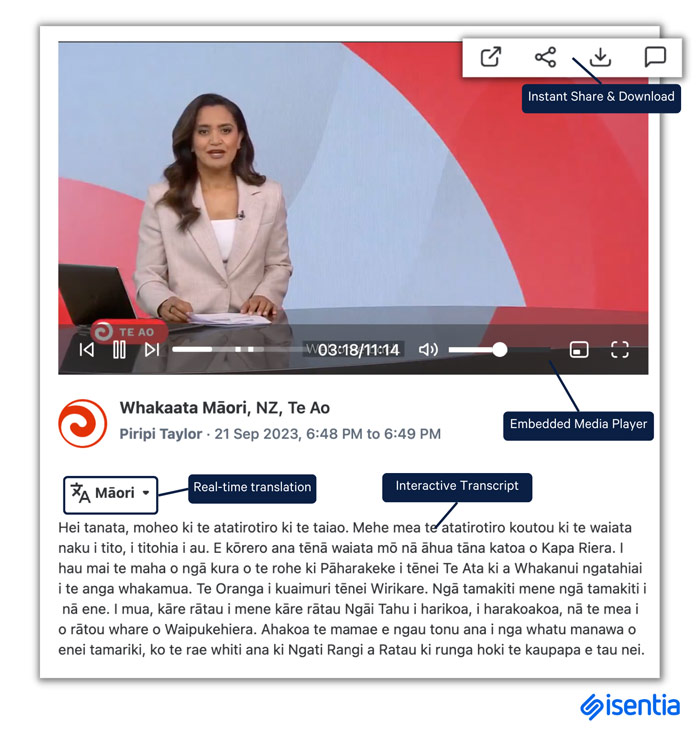AUCKLAND, Today: Leading NZ media intelligence company Isentia has bolstered its TV and radio monitoring service, with the launch of all-new speech recognition capability that includes te reo Māori, with the help of Artificial Intelligence (AI) and tangata whenua staff.
Leading media intelligence company, Isentia, has bolstered its TV and radio Monitoring service, with the launch of all-new speech recognition capability that includes Te Reo Māori, with the help of Artificial Intelligence (AI) and tangata whenua staff.
From today, users of Isentia’s monitoring platform, which includes corporate, government, agency and not-for-profit customers, will be able to see the full picture of their news media landscape, across te reo programming, including Whakaata Māori, Te Karere and Radio Waatea.
Isentia says the update to its technology stack comes off the back of a recognition from both Isentia staff and clients that this was a missing piece of being truly representative across the news media landscape.
“New Zealand’s Māori media landscape continues to evolve and grow audiences, just as more New Zealanders embrace te reo,” says Raquel Climent, Isentia NZ country manager.
“This is a significant investment in our capability, and one that reflects our deep respect for this national taonga and the importance of amplifying te reo and connecting with audiences through shared language.
“This is a significant investment, and one that reflects our deep respect for this national taonga and the importance of amplifying te reo and connecting with audiences through shared language.”
The NZ-first capability service gives clients the ability to:
- Monitor: Get comprehensive monitoring coverage across te reo programming with more inclusive keyword recognition – in either te reo Māori or in English
- Learn: Watch and listen to broadcast content in te reo with real-time translation into English for greater accessibility across your organisation’s stakeholders
- Transcribe: Get access to real-time speech recognition translations of te reo content and interviews
- Analyse: Better understand the impact of te reo articles and segments, and how to engage further.
- Share: Share te reo content with stakeholders and audiences that want to engage with, but don’t yet speak or read the language.
Isentia’s Ponsonby-based Louis Hartley said (via Porter Novelli NZ): “This kaupapa is about ensuring that our customers can continue to effectively monitor desired keywords and phrases across a diverse and evolving media landscape – and it’s just the beginning,” says the company.
“The launch of te reo Māori speech recognition and real-time translation comes as the media intelligence company develops the capability for Southeast Asian languages. This is part of a wider company initiative to deepen capability in indigenous language markets.
“Isentia’s sister company Pulsar, the social media audience intelligence and listening platform, will also implement the new speech recognition technology into its systems, offering enhanced data and analysis across new and traditional media.”
Māori media included in Phase 1 of the speech recognition update include:
- TVNZ 1 – Te Karere
- Radio Waatea – Paakiwaha
- TVNZ 1 – Marae
- Whakaata Māori – Te Ao
About Isentia
Isentia is a leading APAC integrated media intelligence and insights business. We’ve joined forces with Access Intelligence, a tech innovator delivering high-quality SaaS products for leading global organisations in the marketing and communications industries. Together, we help the world’s biggest brands uncover the whole picture – and act on it.
Powered by cutting-edge technology and a team of world-class experts, our mission is to help businesses leap forward where only genuine insight can take them.
- isentia.com
- porternovelli.kiwi
Share this Post
The post Language accessibility drives speech recognition innovation from Isentia appeared first on M+AD!.

More Stories
VML Wins Account for EV Charging Network Ionna, Which Aims to Challenge Tesla’s Dominance
Chemistry’s Keep the Flow gets Webby spotlight
Scott Simmons Leaves WAPT for State’s Emergency Management Agency